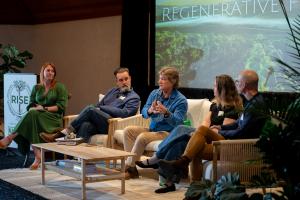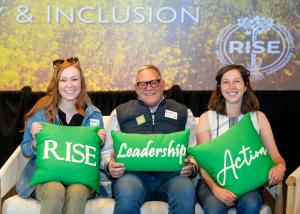The RISE Climate & Wine Symposium Engaged 650 Guests Sharing Leadership Opportunities & Generating Commitments to Action
The aim of RISE is to motivate and support a more regenerative & resilient wine community, and leverage wine’s powerful platform to show what is possible.
RISE established that regenerative agriculture is our future. Chimney Rock Winemaker Elizabeth Vianna, noted, “Biodiversity feels good. It feels right.” Dr. Jonathan Lundgren, Director of Ecdysis Foundation, said, “For every management decision you make you should ask yourself, ‘Am I killing life or am I growing life?’...Farmers are meant to be stewards of life.” Caine Thompson, Managing Director of Robert Hall, shared, “We’ve had a seven percent increase in farming costs, but that’s been more than offset by improved yields and higher quality fruit.” Bedrock Wine Co. owner Morgan Twain-Peterson MW, revealed, “Tilled soil can absorb water at a rate of roughly half an inch per hour. Non-tilled soil can absorb 8-11 inches of water per hour.” Tommy Fenster, PhD candidate at UC Davis, said, “Our research shows the benefits of stacking regenerative practices even without being organic.”
To help accelerate the regenerative movement Napa Green and Thompson, who is also a Regenerative Viticulture Foundation board member, committed to launch the One Block Challenge in the North Bay later this year.
Chris Renfro, founder of The Two Eighty Project, noted, “Wine has the potential to show what diversity can look like in a bottle.” Jermaine Stone, creator of Wine and Hip Hop, said, “When you expand the narrative you expand the market…We have to attach wine to local cultures.” Steve Rasmussen, co-owner of Palisades Canyon, committed to connect with Renfro and explore the opportunity to create an inclusive community vineyard and mentorship space in Calistoga.
Sarah Unger, co-founder of Cultique, shared the concept of “New-stalgia” - a nostalgia for experiences you haven’t yet had, and noted, “The wine industry has the opportunity to create new-stalgia experiences.” Dom De Ville, Sustainability Director at The Wine Society, said, “We have to reframe the narrative of sustainability from sacrifice to joy. Joy drives behavior.” Christian Miller, Director of Research at Wine Market Council, emphasized, “The visibility of credible, easy to understand sustainability claims on the bottle and shelf is critical.” Randi Kronthal-Sacco, Senior Scholar at the NYU Stern Center for Sustainable Business, committed to work with Napa Green to do a consumer study specific to wine and spirits.
Renée Lertzman, climate psychologist and founder of Project InsideOut, shared a powerful quote, “It is hard to learn if you already know.” Brock Dolman, co-founder of the Occidental Arts & Ecology Center, played on words, saying, “We need an ego-system re-story-ation.” Finn Does, a youth climate activist and organizer, who at 19 has already led thousands of students, noted, “Tipping points start inside us.”
Dan Petroski, Massican winemaker and Napa Green Board Chair, told the audience, “I most importantly want to thank the Napa Green team…They are one of the most passionate teams in the Napa Valley. My ask of you is if you want to change the world, and you need help, please call them, lean on them, they want you to succeed. And together we will achieve the mission of a resilient and sustainable Napa Valley, and set a standard for our industry.”
The aim of Napa Green and RISE is to motivate and support a more regenerative and resilient regional wine community, and leverage wine’s powerful leadership platform to show what is possible and hasten the global transition to diverse, healthy farms and conscientious businesses. Learn more and access the RISE recordings and slides at napagreen.org (available by June 2). RISE will return in 2027.
“We have to care for and collaborate with nature, we have to care for and collaborate with each other, as if our lives depend on it. Because they do.” -Anna Brittain, Napa Green
Anna Brittain
Napa Green
+1 805-636-3329
email us here
Visit us on social media:
LinkedIn
Instagram
Facebook
Other
Legal Disclaimer:
EIN Presswire provides this news content "as is" without warranty of any kind. We do not accept any responsibility or liability for the accuracy, content, images, videos, licenses, completeness, legality, or reliability of the information contained in this article. If you have any complaints or copyright issues related to this article, kindly contact the author above.
Happy Father's Day - Training Sons to become responsible fathers
Thorncrest Dental Brings Advanced Laser Dentistry to Etobicoke with Picasso Soft Tissue Laser
Tom Jackobs Offers Fractional Sales Management for Heart-Led Wellness Practices
Kalendarium
Więcej ważnych informacji
 Jedynka Newserii
Jedynka Newserii

 Jedynka Newserii
Jedynka Newserii

Prawo

Trwają dyskusje nad kształtem unijnego budżetu na lata 2028–2034. Mogą być rozbieżności w kwestii Funduszu Spójności czy dopłat dla rolników
Trwają prace nad wieloletnimi unijnymi ramami finansowymi (WRF), które określą priorytety wydatków UE na lata 2028–2034. W maju Parlament Europejski przegłosował rezolucję w sprawie swojego stanowiska w tej sprawie. Postulaty europarlamentarzystów mają zostać uwzględnione we wniosku Komisji Europejskiej w sprawie WRF, który zostanie opublikowany w lipcu 2025 roku. Wciąż jednak nie ma zgody miedzy państwami członkowskimi, m.in. w zakresie Funduszu Spójności czy budżetu na rolnictwo.
Konsument
35 proc. gospodarstw domowych nie stać na zakup mieszkania nawet na kredyt. Pomóc może wsparcie budownictwa społecznego i uwolnienie gruntów pod zabudowę

W Polsce co roku oddaje się do użytku ok. 200 tys. mieszkań, co oznacza, że w ciągu dekady teoretycznie potrzeby mieszkaniowe społeczeństwa mogłyby zostać zaspokojone. Jednak większość lokali budują deweloperzy na sprzedaż, a 35 proc. gospodarstw domowych nie stać na zakup nawet za pomocą kredytu. Jednocześnie ta grupa zarabia za dużo, by korzystać z mieszkania socjalnego i komunalnego. Zdaniem prof. Bartłomieja Marony z UEK zmniejszeniu skali problemu zaradzić może wyłącznie większa skala budownictwa społecznego zamiast wspierania kolejnymi programami zaciągania kredytów.
Problemy społeczne
Hejt w sieci dotyka coraz więcej dzieci w wieku szkolnym. Rzadko mówią o tym dorosłym

Coraz większa grupa dzieci zaczyna korzystać z internetu już w wieku siedmiu–ośmiu lat – wynika z raportu NASK „Nastolatki 3.0”. Wtedy też stykają się po raz pierwszy z hejtem, którego jest coraz więcej w mediach społecznościowych. Według raportu NASK ponad 2/3 młodych internautów uważa, że mowa nienawiści jest największym problemem w sieci. Co więcej, dzieci rzadko mówią o takich incydentach dorosłym, dlatego tym istotniejsze są narzędzia technologiczne służące ochronie najmłodszych.
Partner serwisu
Szkolenia

Akademia Newserii
Akademia Newserii to projekt, w ramach którego najlepsi polscy dziennikarze biznesowi, giełdowi oraz lifestylowi, a także szkoleniowcy z wieloletnim doświadczeniem dzielą się swoją wiedzą nt. pracy z mediami.










.gif)

 |
| |
| |
|